
The Kashmir Valley has long been renowned for its breathtaking landscapes, vibrant culture, and deep-rooted traditions in arts and crafts. Among the many artistic treasures of this region, Pinjrakari stands out as a beautiful and lesser-known craft that blends architectural ingenuity with artistic finesse. This traditional craft, known for its intricate wooden latticework, has been a defining feature of Kashmiri homes for centuries. Let’s take a closer look at this mesmerizing craft, its history, cultural significance, and why it’s essential to preserve and promote it today.
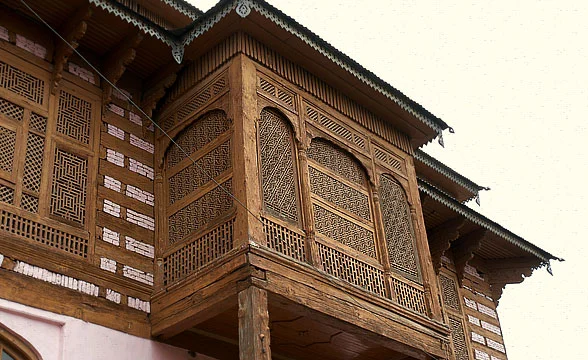
photo/x
Table of Contents
What is Pinjrakari?
At its core, Pinjrakari is the art of wooden latticework, often used in windows, doors, partitions, and other architectural elements in Kashmiri homes. The word “Pinjra” means lattice or cage in Kashmiri, referring to the geometric patterns formed by thin wooden strips that crisscross to create an intricate mesh. This latticework allows light and air to pass through while maintaining privacy, making it a functional and aesthetic part of Kashmiri architecture.
Pinjrakari is not just a random collection of wooden pieces glued together; it is an art form that requires skill, precision, and creativity. The wooden strips, often made of walnut or deodar wood, are arranged to create patterns ranging from simple grids to elaborate geometric designs that reflect Kashmiri aesthetics.
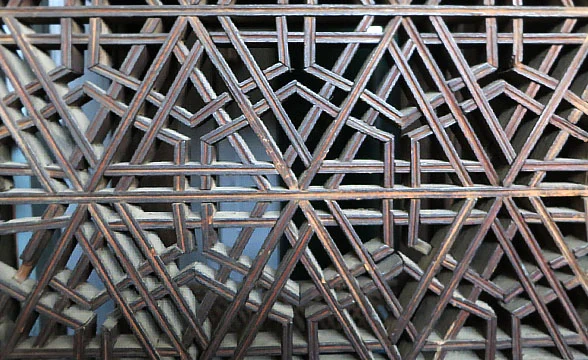
photo/gaatha
Understanding Pinjrakari: The Craft of Intricate Geometry
“Pinjra-Kari” is a craft of making screens of interwoven wooden laths, forming intricate geometric patterns. Traditionally used in elements of architecture like windows, balconies, partitions, and ventilators, these lattice patterns are based on Islamic geometry, where the circle brings forth three fundamental shapes: the triangle, the square, and the hexagon. The triangle symbolizes human consciousness and harmony; the square represents physical expression or materiality; and the hexagon represents Heaven.
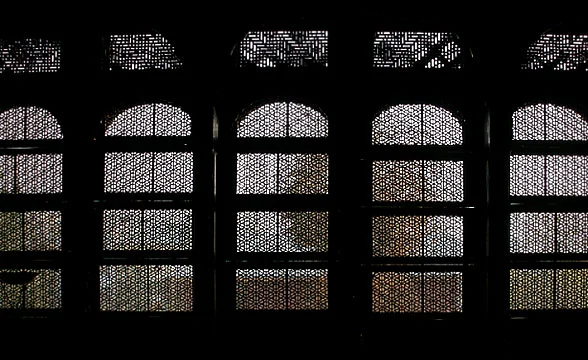
photo/Office of the Development Commissioner – Handicrafts
The Functional Beauty of Pinjra: More Than Just Aesthetic
These exquisite lattices bring into being a fascinating play of light all day long, creating sublime moments between the dweller and the beholder. Adorning the windows and extended balconies called Zoondans or moon observatories, Pinjras had functional attributes beyond mere decoration. Valued for their privacy, they cleverly controlled the sun in summers and cold drafts during the extreme winters. In winter, they were covered with a layer of oiled paper to keep away the cold breeze, insulating the space inside and creating a greenhouse effect. The paper used for this was made locally and was known as Khosur Kagaz. In India, the first paper industry was developed in Kashmir, established by Sultan Zainul Abedin during his reign from 1417 to 1467 AD. This industry catered to the demands of a large craft sector involved in Naqashi, a fine art of miniature painting on paper and papier-mâché products.
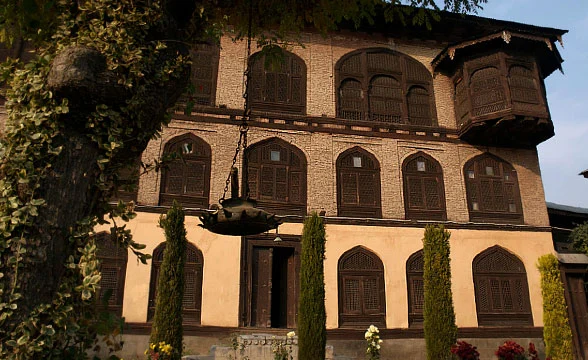
photo/gaatha
The Craftsmanship Behind Pinjrakari: Skills and Techniques
Creating a Pinjra requires an artisan, or Pinjra-Chan, to possess a profound understanding of geometry and a dexterity in using tools for wood and construction methods. The construction of a Pinjra utilizes precision hand tools of exceptional quality; one can see the impressions of these fine tools in old Pinjrakari when looked at closely.
The process involves interlocking small pieces of wooden laths into a geometric pattern, resulting in a beautiful lattice. There are two types of joints used: the halved lap with a bridle joint and the simple tenon and mortise joint. The halved lap and bridle joint is formed by making grooves in the baton. These grooves vary in shape and size depending on the thickness of the batten and the type of design. It could be a rhombus, rectangle, or cube. These grooves form by removing material on one side of the batten at previously fixed intervals. The groove of one batten fits into the groove of another, creating an interlocking pattern. Depending on the desired aesthetic, the grooves in a batten can be on one side or both sides. The geometry and construction of these joints exert tensional pressure, akin to weaving, and keep the laths in position without the use of glues or nails. An outer frame that holds this delicate lattice also acts as a structural member for windows and other applications.
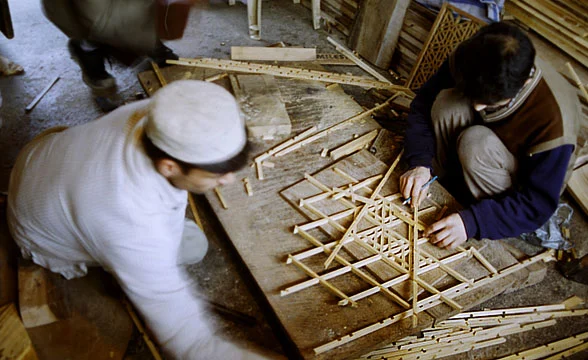
photo/gaatha
The Unique Materials of Pinjrakari: A Symphony of Wood
Four kinds of trees supply wood for this art of Pinjra-kari: Kaiur or yar (Deodar, Himalayan blue pine), Budloo or Sun-Gal (Himalayan silver fir), and Doon Hut (Walnut). The patterns of Pinjra are crafted from a selection of traditional designs. Craftsmen have developed a set of scales called Kannat for different patterns. The Kannat, or measurements, simplify the process of cutting the battens into various lengths and sizes. Skilled artisans can create highly complex designs without needing to resort to mathematics each time, relying instead on the intrinsic nature of repeated components that make the process mechanical. These Kannats are the formulas inherited from one generation to another, a thread connecting past and present.
A fine mud coating is sometimes applied as a protective finish for a longer life. This coating acts as a binding agent, holding all the small pieces in place. Kashmiri Pinjra-kari is unique, setting itself apart from other forms of latticework found in stone, metal, or wood across the globe. Its uniqueness lies in the fineness of the batons; sections can be as fine as 5 mm thick and 18 mm wide. Larger square sections of 20 x 20 mm are used for simpler patterns, such as perpendicular batons crossing each other. Simple grooves running along the center of the batons and minute notches along their width add to the visual intricacies. A simple “V” notch on a square opening creates an eight-pointed star profile.
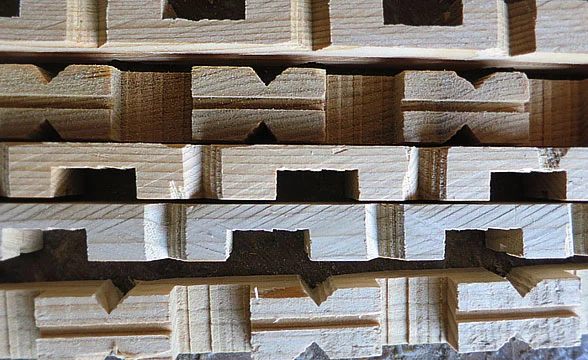
photo/gaatha
Also Read: India-Gujarat: Batic/Batik From Mundra, Kutch
The Symbolism of Stars: Islamic Geometry in Art
The star, prevalent in Islamic art, serves as a chosen motif for many Islamic decorations. In Islamic iconography, the star is a regular geometric shape that symbolizes equal radiation in all directions from a central point. All regular stars—whether they have 6, 8, 10, 12, or 16 points—are created by dividing a circle into equal parts. The center of the star is the center of the circle from which it originated, and its points touch the circumference. The rays of a star reach out in all directions, making it a fitting symbol for the spread of Islam.

photo/baelezamag
The Decline of a Traditional Craft: Modern Challenges
Over time, this craft languished due to its high value, time-consuming nature, and the decline in patrons. Modern materials like glass, metal grills, and readymade industrial mesh have replaced traditional Pinjra. Some artisans and walnut wood carvers have taken up the art of making while repairing and restoring old Pinjra, catering to the local needs. However, Pinjra-kari today is not practiced in its traditional manner of interlocking batons; the use of glue or nails is prevalent now due to its complexity.
Historical Roots of Pinjrakari
The history of Pinjrakari dates back centuries, rooted in the rich cultural exchanges that shaped the region. Kashmir, situated at the crossroads of Central Asia and the Indian subcontinent, absorbed influences from Persian, Mughal, and Central Asian cultures. These interactions inspired local artisans to develop their distinct form of latticework.
The origins of Pinjra-kari, as practiced by Shah Hamadani and his disciples dating back to 1373-1476, can be traced to Tral, a remote village east of Awantipora. A Namda Gari Mohala and Zadibal area in Srinagar still bear traces of fine Pinjra-kari. Also visible are remnants of dilapidated Pinjras on abandoned ruins of houses scattered across the valley.
Pinjra-kari can be traced back to the Mughal era when Kashmir’s artistic landscape blossomed under royal patronage. During this time, Mughal rulers like Emperor Akbar and Shah Jahan were known to appreciate and promote various forms of art, including architecture, painting, and crafts. Under their influence, Kashmiri craftsmen began incorporating Islamic architectural elements into their work, including the intricate geometric patterns seen in Pinjra-kari.
However, the roots of this craft go even deeper, drawing inspiration from Persian and Central Asian architecture, where latticework played a prominent role. Kashmiri artisans refined and adapted these influences to suit local needs and aesthetics, giving birth to what we now know as Pinjrakari.
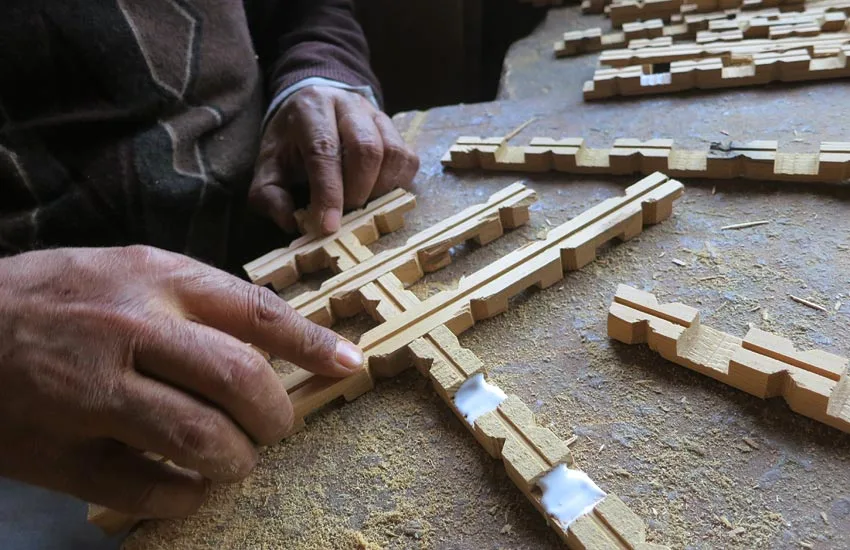
photo/gaatha
The Functionality of Pinjrakari
While Pinjrakari is undeniably beautiful, its charm goes beyond aesthetics. In fact, one of the reasons it has endured through the centuries is its functionality. In a region like Kashmir, where summers can be hot and winters biting cold, the latticework serves practical purposes.
First, the lattice design allows air circulation, keeping homes cool during the warm months. The spaces between the wooden strips enable a gentle breeze to flow through, providing natural ventilation. At the same time, the lattice offers privacy, a crucial aspect in traditional Kashmiri households. Women, in particular, could observe the outside world without being seen, thanks to the semi-transparent nature of the latticework.
During the colder months, many homes would install glass panes behind the Pinjra-kari windows, transforming the lattice into a decorative element while still allowing light to filter through. Thus, Pinjra-kari plays a dual role—enhancing both aesthetic appeal and comfort.
The Cultural Significance of Pinjrakari
Pinjrakari is more than just a form of craft; it’s deeply embedded in Kashmiri culture and identity. The patterns and motifs often found in this latticework are a reflection of the valley’s rich cultural tapestry. Traditional designs often feature geometric shapes like hexagons, stars, and crosses, which are symbolic of Islamic art and architecture. These geometric designs are believed to represent the infinite nature of the universe, offering spiritual and philosophical significance to the craft.
Moreover, Pinjrakari is also an important marker of social and economic status in Kashmiri society. Historically, homes with elaborate Pinjrakari latticework were often those of wealthy families or influential individuals. The craftsmanship involved in creating these intricate designs was costly, making it a luxury for the elite. Over time, however, the craft became more accessible, with simpler designs gracing the homes of the middle class as well.
Pinjra-kari also plays a crucial role in wedding traditions. In many Kashmiri households, Pinjra-kari screens are used as decorative elements during wedding ceremonies, symbolizing the union of two families and the beginning of a new life. The delicate beauty of the latticework mirrors the intricate bonds of marriage, making it a meaningful part of the celebration.
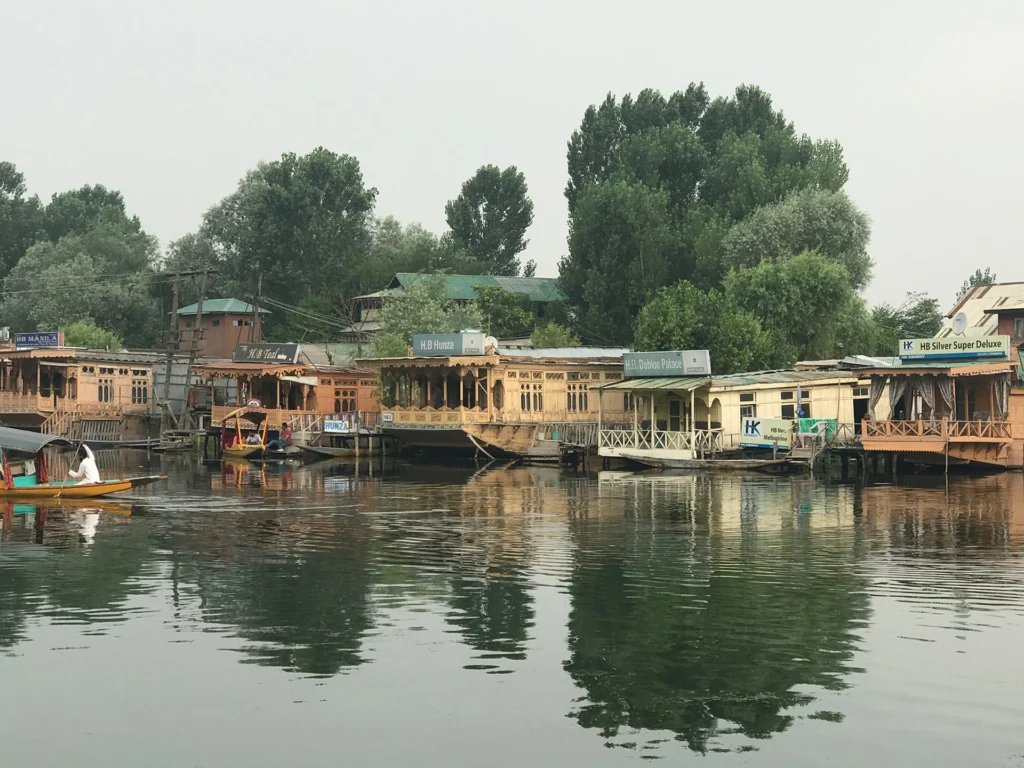
photo/stirworld
Pinjrakari in Modern Times
While Pinjrakari has a rich history, the craft has faced significant challenges in recent years. The rise of modern architectural styles and the use of synthetic materials have led to a decline in demand for traditional wooden latticework. Many skilled artisans have shifted to other trades, leading to a loss of expertise in the craft.
However, there has been a renewed interest in preserving and promoting Pinjrakari in recent times. Several organizations and individuals are working to revive this ancient craft by incorporating it into contemporary designs and promoting it as a valuable aspect of cultural heritage.
Architects and interior designers are now rediscovering the beauty and functionality of Pinjrakari, using it in modern homes and commercial spaces. From boutique hotels to luxury residences, Pinjrakari is making a comeback as a symbol of elegance and tradition. Some designers are even experimenting with new materials, such as metal and glass, to give the traditional latticework a contemporary twist.
Efforts to train new generations of artisans are also underway, ensuring that the skills required for Pinjrakari are passed on. Government initiatives and private organizations have started offering workshops and apprenticeships to young craftsmen, encouraging them to learn and preserve this heritage craft.
The Importance of Preserving Pinjrakari
Pinjrakari is not just a craft; it’s a link to Kashmir’s artistic past and cultural identity. In a world that is increasingly leaning towards homogenization, preserving traditional crafts like Pinjrakari is crucial to maintaining the diversity and richness of global cultures.
Additionally, promoting Pinjrakari can have a positive impact on the local economy. By supporting the artisans who create this beautiful work, we can help revive a craft that has been on the brink of extinction. This, in turn, can lead to the sustainable development of the region, providing livelihoods to local communities while keeping the art alive.
Modern Applications of Pinjrakari
As we move further into the 21st century, we see a growing appreciation for sustainable design and locally sourced craftsmanship. In this context, Pinjrakari has found new relevance in contemporary interior design. While it was once a hallmark of traditional Kashmiri homes, today, it is making its way into luxury apartments, urban restaurants, boutique hotels, and even office spaces across India and beyond.
In modern homes, Pinjrakari is used not only for windows but also as room dividers, headboards, and even wall art. The intricate patterns allow light to filter in, creating stunning shadow play, which adds an element of warmth and depth to interior spaces. Additionally, Pinjrakari screens can be customized to suit modern tastes, offering a perfect blend of traditional charm and contemporary elegance.
Many designers are also experimenting with non-traditional materials, such as metal, glass, or even plastic, to create a contemporary take on this ancient craft. These innovations have allowed Pinjrakari to evolve while maintaining its core identity, offering endless possibilities for architects and interior designers.
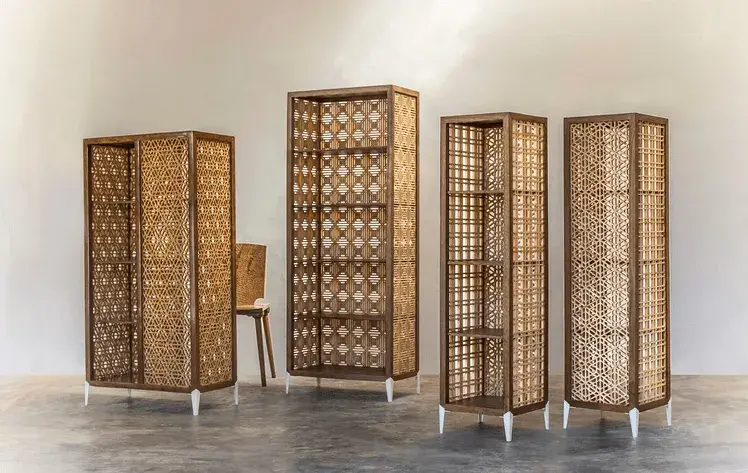
photo/authindia
Revival Efforts and the Role of Artisans
The revival of Pinjrakari has been a community-driven effort, with both the public and private sectors recognizing the need to preserve this craft. Several organizations, including government bodies, NGOs, and private cultural preservation groups, are working closely with local artisans to ensure the survival of the craft.
One key aspect of this revival is training and education. Many of the current artisans practicing Pinjrakari are older generations who learned the craft through apprenticeships passed down from their forefathers. However, with changing times, there has been a noticeable decline in the number of young people interested in learning the trade. To combat this, various initiatives have been launched to train younger generations in the craft of Pinjrakari. These efforts often include workshops, apprenticeships, and collaboration with design schools to bring in fresh ideas while staying true to traditional techniques.
Another important aspect of the revival is promoting Pinjrakari as a luxury product. By framing the craft as something that is not only culturally significant but also valuable in a modern design context, artisans can charge higher prices for their work, ensuring the sustainability of the craft. This shift in perception—from Pinjrakari as a simple functional element to a luxury item—has helped elevate its status in the design world.
Cultural Tourism and the Economic Potential of Pinjrakari
With Kashmir’s rich history, culture, and natural beauty, the region has long been a destination for travelers seeking both adventure and tranquility. In recent years, the promotion of cultural tourism has helped shine a spotlight on traditional Kashmiri crafts like Pinjrakari.
Tourists visiting the region are increasingly drawn to the handicrafts that define the unique identity of Kashmir. Pinjrakari, with its intricate beauty and historical significance, has become a popular souvenir, especially for those looking for something meaningful and authentic. Whether it’s a small Pinjrakari window frame or a large room divider, these pieces are not just functional; they are works of art that carry a piece of Kashmir’s soul.
By promoting Pinjrakari through tourism, local artisans have a platform to showcase their work to a global audience. This not only helps boost the local economy but also fosters a deeper appreciation for Kashmiri culture among visitors. Some tour operators and cultural preservation groups now offer craft tours where tourists can visit artisan workshops and see the Pinjrakari-making process firsthand. These tours provide an immersive experience and often lead to direct purchases, benefitting both the artisans and the local economy.
Additionally, the rise of e-commerce has opened up new avenues for Pinjrakari artisans to sell their work. Platforms dedicated to promoting traditional crafts allow these artisans to reach a global customer base without the need for middlemen. This direct-to-consumer approach ensures that artisans receive fair compensation for their labor while also allowing customers to purchase one-of-a-kind pieces from the comfort of their homes.
Pinjrakari as a Symbol of Resilience
Kashmir has seen its fair share of political and social turmoil over the years, which has often impacted the region’s economy, especially the artisanal sector. However, despite these challenges, the art of Pinjrakari has endured, a testament to the resilience of both the craft and the people who practice it.
In many ways, Pinjrakari is a metaphor for Kashmir itself—fragile yet strong, intricate yet enduring. The craft has withstood the test of time, surviving generations of change and adaptation. It has faced the brunt of modernization, yet continues to find new ways to remain relevant. This resilience is not just a reflection of the craft but also of the Kashmiri people, who continue to hold on to their heritage even in the face of adversity.
The Future of Pinjrakari
The future of Pinjrakari looks promising, thanks to the concerted efforts of artisans, designers, cultural preservationists, and consumers who value authenticity. As more people become aware of the importance of preserving traditional crafts, the demand for handmade, sustainable products is growing.
One of the exciting possibilities for Pinjrakari is its potential for cross-cultural collaboration. Imagine a fusion of traditional Kashmiri latticework with modern Scandinavian minimalism, or the incorporation of Pinjrakari into Japanese-inspired interiors. These kinds of collaborations can introduce the craft to new audiences and ensure that it evolves while maintaining its essence.
Moreover, as the world moves towards sustainable living, crafts like Pinjrakari are gaining traction as eco-friendly alternatives to mass-produced products. The use of locally sourced, sustainable wood and the handcrafted nature of Pinjrakari make it a perfect choice for those looking to minimize their environmental impact. This shift towards conscious consumption will likely play a crucial role in ensuring the craft’s longevity.
Conclusion: A Craft Worth Celebrating
Pinjrakari is not just an art form; it is a living testament to the rich history, culture, and craftsmanship of Kashmir. From its early beginnings under Mughal influence to its modern-day resurgence, Pinjrakari has woven itself into the fabric of Kashmiri life, offering both beauty and functionality.
As we look to the future, it’s crucial to continue supporting the artisans who dedicate their lives to preserving this craft. Whether through purchasing Pinjrakari pieces, promoting cultural tourism, or advocating for its inclusion in modern design, we all have a role to play in ensuring that this extraordinary craft endures for generations to come.
In a world that often prioritizes speed and efficiency over tradition and craftsmanship, Pinjrakari stands as a reminder of the value of patience, skill, and artistry. It is a craft that invites us to slow down, appreciate the beauty of the intricate, and recognize the stories woven into every piece of wood. The art of Pinjrakari is truly a jewel in the crown of Kashmiri culture—a treasure worth preserving, celebrating, and sharing with the world.
FAQs
1. What is Pinjrakari?
Pinjrakari is the traditional art of creating intricate wooden latticework, commonly used in windows, doors, and partitions in Kashmiri architecture. The term “Pinjra” translates to “lattice” or “cage,” referring to the geometric patterns formed by thin wooden strips.
2. What materials are used in Pinjrakari?
The primary materials used in Pinjrakari are durable woods like walnut, deodar, and poplar. These woods are chosen for their workability, strength, and natural beauty.
3. How is Pinjrakari created?
Artisans begin by selecting quality wood and cutting it into thin strips. These strips are then carefully assembled into intricate patterns without the use of nails or glue, relying on traditional joinery techniques.
4. What are the functions of Pinjrakari?
Pinjrakari serves both aesthetic and functional purposes. It allows natural light and air to circulate while providing privacy. The latticework can also be combined with glass panes during colder months, enhancing its functionality.
5. What is the historical significance of Pinjrakari?
Pinjrakari has deep historical roots in Kashmir, influenced by Persian and Mughal architecture. It has evolved over centuries, reflecting the region’s cultural exchanges and craftsmanship.
6. Is Pinjrakari still relevant today?
Yes, Pinjrakari is experiencing a revival as designers and architects are rediscovering its beauty and functionality. It is being incorporated into modern interiors and architectural designs, making it relevant in contemporary settings.
7. How can I purchase Pinjrakari products?
Pinjrakari products can often be found in local handicraft shops in Kashmir, art galleries, and online platforms that promote traditional crafts. Some artisans also offer custom-made pieces.
8. What efforts are being made to preserve Pinjrakari?
Various organizations, NGOs, and government initiatives are working to preserve and promote Pinjrakari by providing training and education for younger artisans, encouraging cultural tourism, and raising awareness about the craft’s significance.
9. How can I support Pinjrakari artisans?
You can support Pinjrakari artisans by purchasing their products, promoting cultural tourism in Kashmir, and sharing information about the craft on social media. Supporting initiatives that aim to preserve traditional crafts is also beneficial.
10. Are there workshops available for learning Pinjrakari?
Yes, there are workshops and training programs organized by various cultural organizations and artisan cooperatives in Kashmir. These programs aim to teach the craft to younger generations and keep the tradition alive.